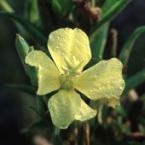Evening Primrose Oil

On this page:
Introduction
This fact sheet provides basic information about evening primrose oil—common names, what the science says, potential side effects and cautions, and resources for more information.
Evening primrose is a plant native to North America, but it grows in Europe and parts of the Southern hemisphere as well. It has yellow flowers that bloom in the evening. Evening primrose oil contains gamma-linolenic acid (GLA), an essential fatty acid. Essential fatty acids are required by the body for growth and development, and must be obtained from the diet.
Evening primrose oil has been used since the 1930s as a folk or traditional remedy for eczema (a condition in which the skin becomes inflamed, itchy, or scaly because of allergies or other irritation). More recent folk uses include other conditions involving inflammation, such as rheumatoid arthritis; conditions affecting women’s health, such as breast pain associated with the menstrual cycle, menopausal symptoms, and premenstrual syndrome (PMS); cancer; and diabetes.
Evening primrose oil is extracted from the seeds of the evening primrose. The oil is usually put into capsules for use.
What the Science Says
- Evening primrose oil may have modest benefits for eczema, and it may be useful for rheumatoid arthritis and breast pain. However, study results are mixed, and most studies have been small and not well designed.
- Evening primrose oil does not appear to affect menopausal symptoms.
- Although some clinical trials have shown a benefit of evening primrose oil for PMS, the best-designed trials found no effect.
- There is not enough evidence to support the use of evening primrose oil for other health conditions.
Side Effects and Cautions
- Evening primrose oil is well tolerated by most people. Mild side effects include gastrointestinal upset and headache.
- Tell all your health care providers about any complementary health practices you use. Give them a full picture of what you do to manage your health. This will help ensure coordinated and safe care. For tips about talking with your health care providers about complementary and alternative medicine, see NCCAM's Time to Talk campaign.
Sources
- Evening primrose oil. Natural Medicines Comprehensive Database Web site. Accessed at www.naturaldatabase.com on June 11, 2009.
- Evening primrose oil (Oenothera biennis L.). Natural Standard Web site. Accessed at www.naturalstandard.com on June 11, 2009.
- Shahidi F, Miraliakbari H. Evening primrose (Oenothera biennis). In: Coates P, Blackman M, Cragg G, et al., eds. Encyclopedia of Dietary Supplements. New York, NY: Marcel Dekker; 2005:197–210.
For More Information
NCCAM Clearinghouse
The NCCAM Clearinghouse provides information on NCCAM and complementary health approaches, including publications and searches of Federal databases of scientific and medical literature. The Clearinghouse does not provide medical advice, treatment recommendations, or referrals to practitioners.
PubMed®
A service of the National Library of Medicine (NLM), PubMed® contains publication information and (in most cases) brief summaries of articles from scientific and medical journals.
Office of Dietary Supplements (ODS), National Institutes of Health (NIH)
ODS seeks to strengthen knowledge and understanding of dietary supplements by evaluating scientific information, supporting research, sharing research results, and educating the public. Its resources include publications (such as Dietary Supplements: What You Need to Know), fact sheets on a variety of specific supplement ingredients and products (such as vitamin D and multivitamin/mineral supplements), and the PubMed® Dietary Supplement Subset.
NIH National Library of Medicine's MedlinePlus
This publication is not copyrighted and is in the public domain. Duplication is encouraged.
* Note: PDF files require a viewer such as the free Adobe Reader.



